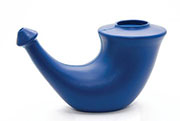- Skip Storing This Everyday Product in the Fridge Door
- Green Tea + B3 Pairing May Boost Brain Health
- Navigating Your Midlife Crisis: Embracing New Possibilities
- City Raccoons Showing Signs of Domestication
- Mapping the Exposome: Science Broadens Focus to Environmental Disease Triggers
- One Week Less on Social Media Linked to Better Mental Health
- Your Brain Changes in Stages as You Age, Study Finds
- Some Suicide Victims Show No Typical Warning Signs, Study Finds
- ByHeart Formula Faces Lawsuits After Babies Sickened With Botulism
- Switch to Vegan Diet Could Cut Your Greenhouse Gas Emissions in Half
Take Infection Precautions When Using Nasal-Rinsing Products: FDA


FRIDAY, Oct. 11Neti pots and other nasal-rinsing devices are generally safe and useful products, but they must be used and cleaned properly to reduce the risk of infection, according to the U.S. Food and Drug Administration.
These products are used to rinse the nasal passages with a salt-based solution and are a popular treatment for congested sinuses, colds and allergies, and for moistening nasal passages exposed to dry indoor air.
The most important factor in the safe use of nasal-rinsing devices is the water source. Tap water that is not filtered, treated or processed in specific ways is unsafe because it may contain bacteria or other organisms that can cause infections.
In 2011, two people in Louisiana died of a rare brain infection that may have been caused by improper use of neti pots, the FDA said in a consumer update reviewed by the agency last month.
Water that is safe to use in nasal-rinsing devices includes distilled or sterile water, which can be bought in stores. Or you can boil tap water for three to five minutes and then allow it to cool until it is lukewarm. You can store previously boiled water in a clean, closed container for use within 24 hours.
Another option is to pass water through a filter with an absolute pore size of 1 micron or smaller, which traps potentially infectious organisms. You can buy these filters online or at hardware stores. The U.S. Centers for Disease Control and Prevention has information about choosing a filter.
Wash and dry your hands before using a nasal-rinsing device, and check that it is clean and completely dry. Follow the manufacturer’s directions for use. When you’re done, wash the device with distilled, sterile or boiled and cooled tap water, and then dry the inside with a paper towel or let it air dry, the FDA recommends.
If a doctor recommends it, nasal-rinsing devices can be used on children as young as age 2, according to the agency. Very young children, however, might not tolerate the procedure as well.
Before using a nasal-rinsing device, talk to your doctor to determine if it will be safe and effective for your condition. If your symptoms worsen or do not improve, go back to your doctor, especially if you experience fever, nosebleed or headache while using a nasal-rinsing device, the FDA advised.
More information
The American Academy of Otolaryngology — Head & Neck Surgery has more about sinus problems.
Source: HealthDay
Copyright © 2025 HealthDay. All rights reserved.










